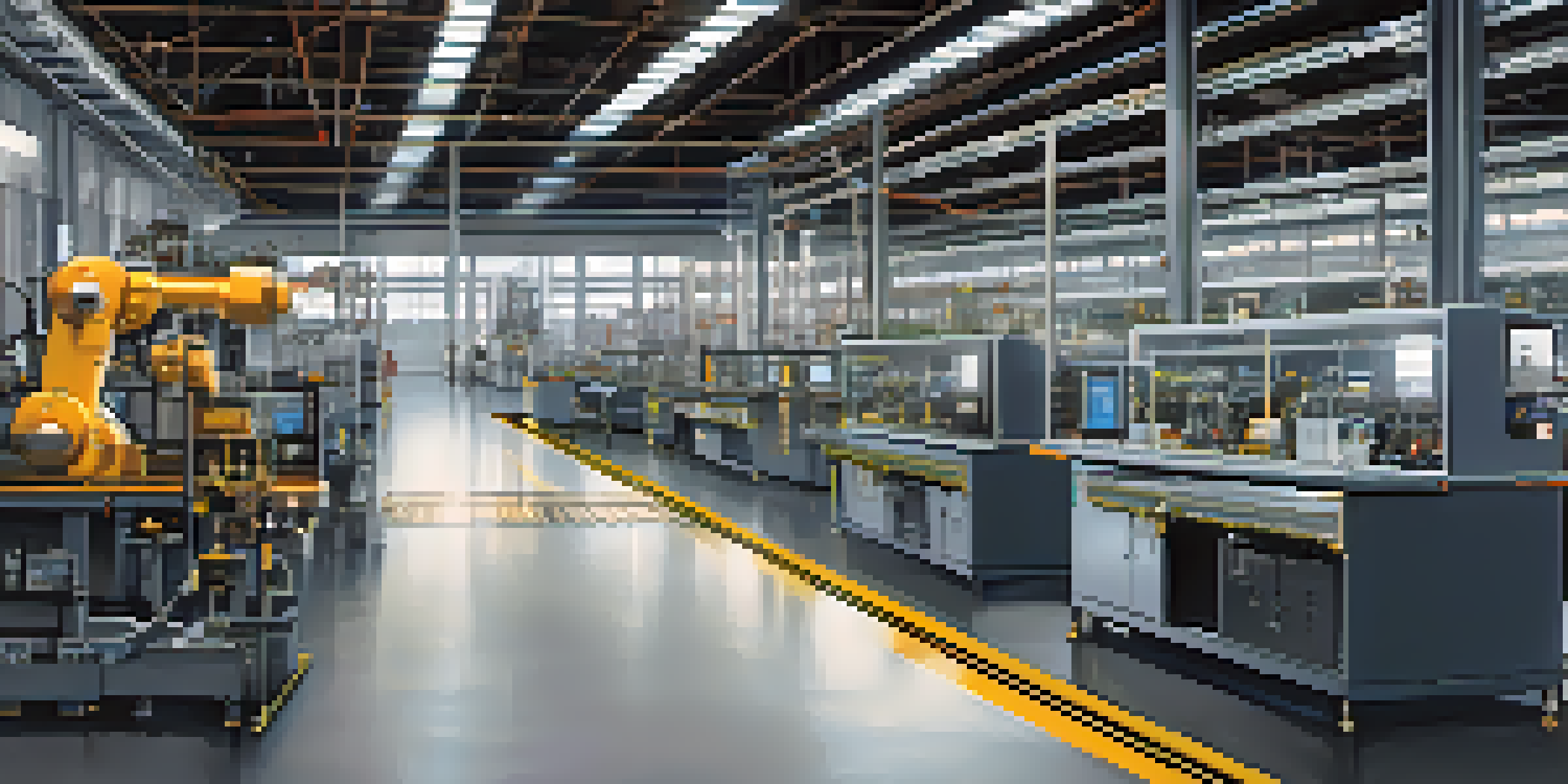How IoT Enhances Remote Monitoring in Various Sectors

Understanding IoT and Remote Monitoring
The Internet of Things (IoT) refers to a network of interconnected devices that collect and exchange data. This technology has revolutionized various sectors by enabling remote monitoring, which allows organizations to oversee operations without being physically present. For instance, imagine a farmer who can check soil moisture levels from their smartphone, adjusting irrigation systems from afar.
The Internet of Things is not a trend, it’s a tool that will help us make the world a better place.
Remote monitoring powered by IoT leads to efficiency and faster decision-making. Instead of relying on manual checks, sensors provide real-time data, allowing for immediate action when needed. This technology not only saves time but also reduces human error, ensuring more accurate monitoring.
As IoT continues to evolve, its integration into remote monitoring is becoming more sophisticated. With advancements in artificial intelligence (AI) and machine learning, these systems can not only report data but also analyze patterns and predict future outcomes, further enhancing their utility.
IoT in Healthcare: Remote Patient Monitoring
In the healthcare sector, IoT plays a vital role in remote patient monitoring, allowing doctors to track patient health from anywhere. Wearable devices collect data like heart rate and blood glucose levels, sending this information directly to healthcare providers. This timely access to patient data can be life-saving, enabling quick interventions when necessary.

Moreover, remote monitoring reduces the need for regular hospital visits, which can be a burden for many patients. Instead, individuals can manage their health from the comfort of their homes, leading to better adherence to treatment plans. For instance, a heart patient can be monitored using a wearable device that alerts the medical team if any irregularities are detected.
IoT Enhances Remote Monitoring
The Internet of Things (IoT) enables organizations to oversee operations and make informed decisions remotely through real-time data collection.
The integration of IoT in healthcare not only enhances patient care but also improves operational efficiency. Hospitals can optimize their resources by monitoring equipment and patient flow, ensuring that healthcare services are both effective and efficient.
IoT in Agriculture: Smart Farming Practices
The agricultural sector is witnessing a transformation thanks to IoT, leading to what is now termed 'smart farming.' Farmers use sensors to monitor soil conditions, crop health, and weather patterns, all of which can be accessed remotely. This data-driven approach allows for more informed decisions, such as when to plant or irrigate.
IoT has the potential to change the way we live and work, making everything smarter and more efficient.
For example, a farmer can install moisture sensors in their fields, signaling when irrigation is needed. This not only conserves water but also enhances crop yield. By utilizing IoT technologies, farmers can achieve greater efficiency and sustainability in their practices.
Additionally, remote monitoring in agriculture helps in pest management and disease prevention. By continuously monitoring crops, farmers can detect issues early and apply targeted treatments, reducing the reliance on chemical pesticides and promoting an eco-friendly approach.
IoT in Manufacturing: Enhanced Operational Efficiency
In the manufacturing sector, IoT facilitates remote monitoring of machinery and production lines, leading to significant operational improvements. Sensors can detect equipment performance in real time, providing insights that can prevent breakdowns and reduce downtime. Think of it as having a virtual mechanic who alerts you before a problem escalates.
This proactive approach not only saves time but also cuts costs associated with repairs and lost production. For instance, a factory can schedule maintenance when machines are underutilized, rather than waiting for a malfunction to occur. Such foresight is invaluable in maintaining high productivity levels.
IoT Transforms Healthcare
In healthcare, IoT facilitates remote patient monitoring, allowing for timely interventions and improved patient management from home.
Moreover, IoT enhances supply chain management by providing visibility into inventory levels and shipment statuses. Companies can track their products from production to delivery, ensuring that resources are allocated efficiently and customer demands are met promptly.
IoT in Transportation: Fleet Management Innovations
Transportation is another sector greatly enhanced by IoT through advanced fleet management systems. Companies can monitor vehicle locations, fuel consumption, and driver behavior in real time. This data helps in optimizing routes, reducing fuel costs, and improving overall efficiency.
For instance, a delivery service can adjust routes based on traffic conditions or weather changes, ensuring timely deliveries. Additionally, by monitoring driver behavior, companies can implement safety initiatives that lead to fewer accidents and lower insurance costs.
Furthermore, IoT technology can also facilitate predictive maintenance for vehicles. By analyzing data from sensors, companies can identify potential issues before they become serious problems, thereby extending the lifespan of their fleet and enhancing safety.
IoT in Energy Management: Smart Grids and Monitoring
In the energy sector, IoT is a game-changer for remote monitoring through the development of smart grids. These grids use IoT technology to monitor energy consumption and distribution in real time. This capability allows utilities to optimize energy flow and respond swiftly to outages or demand fluctuations.
For example, homeowners can use smart meters to track their energy usage, adjust consumption patterns, and even participate in demand response programs. This not only helps consumers save on energy bills but also contributes to a more sustainable energy ecosystem.
Challenges in IoT Implementation
Despite its benefits, IoT implementation faces challenges like data security, integration complexity, and the need for standardization across devices.
Additionally, IoT-enabled energy management systems can aid in integrating renewable energy sources into the grid. By monitoring the variability of solar and wind energy, utilities can better manage energy storage and distribution, ensuring a reliable energy supply.
Challenges and Considerations in IoT Implementation
While IoT offers numerous benefits for remote monitoring, there are challenges that organizations must consider. Data security is a significant concern, as the more devices connected to the internet, the higher the risk of cyberattacks. Companies must invest in strong security measures to protect sensitive information.
Moreover, the integration of IoT systems can be complex and may require significant investment. Organizations need to assess their infrastructure and ensure they have the necessary resources and expertise to implement these technologies effectively. This can be a daunting task for smaller businesses with limited budgets.

Lastly, the need for standardization across devices and platforms presents another hurdle. With various manufacturers producing IoT devices, ensuring compatibility and interoperability can be challenging. Industry collaboration and clear guidelines are essential for the successful implementation of IoT solutions.
The Future of IoT in Remote Monitoring
Looking ahead, the future of IoT in remote monitoring is promising, with advancements in technology set to drive further innovation. As 5G networks become more widespread, the speed and reliability of data transmission will improve exponentially. This will enable even more real-time applications across various sectors.
Additionally, the integration of artificial intelligence and machine learning with IoT will create smarter systems capable of predictive analytics. This means businesses can anticipate needs and outcomes, leading to enhanced decision-making and resource allocation.
Moreover, as sustainability efforts become increasingly important, IoT will play a crucial role in monitoring and managing environmental impacts. From tracking emissions to optimizing energy use, IoT technologies will help organizations meet their sustainability goals while improving operational efficiency.